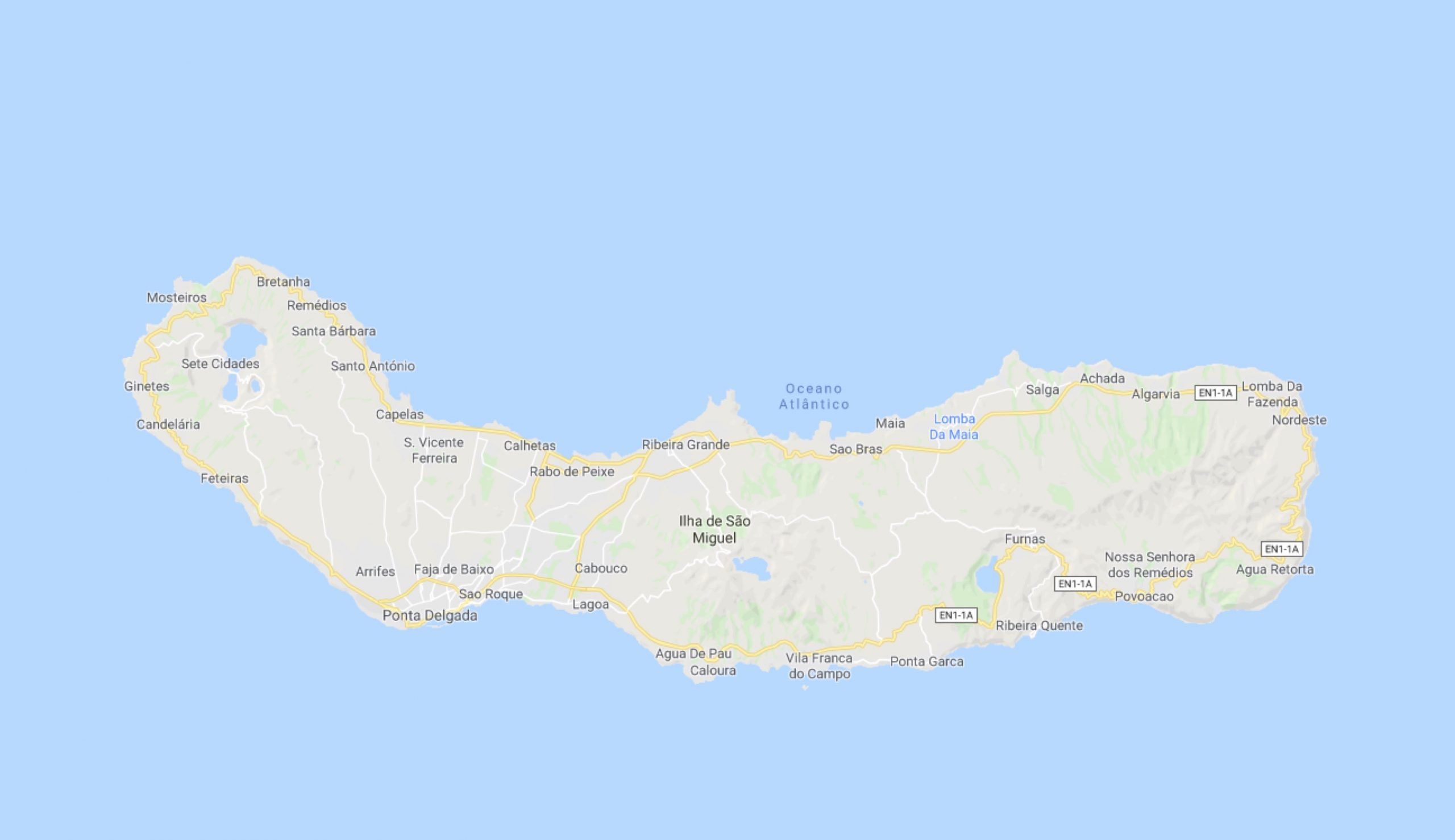
GEOGRAPHY
São Miguel Island is the largest in the Azores Islands, with 62.1 km in length and 15.8 in maximum width. The area of 744.7 km2 hosts more than half of the Azorean population: 137,856 inhabitants (data from 2011). São Miguel, together with the island of Santa Maria, located 81 km south east, forms the Eastern Group of the Azores archipelago. Its highest point (1105 m) corresponds to the Pico da Vara, at 37 ° 48’34 ‘ ‘north latitude and 25 ° 12’40’ ‘west longitude.
HISTORY
São Miguel was probably discovered by Portuguese navigators between 1427 and 1431, immediately after Santa Maria. The initial population dates back to the decade of 1440, under the leadership of Gonçalo Velho Cabral, and was undertaken by colonists from the northern regions, Extremadura, Algarve and Alentejo.
The history of the Azores
Then came black and Jewish communities, and other foreigners (especially French and English). The fertile land and the existence of safe coves quickly made the island a commercial platform. Its economic growth was essentially based on the cultivation and export of wheat and ford, the two products that stimulated the population of the island.
Until the earthquake of October 1522, which left a trail of destruction behind it, the capital was Vila Franca do Campo. Ponta Delgada then gained a fundamental role, and was elevated to the category of city in 1546. The last part of the 16th century was marked by many pirate attacks; São Miguel was also occupied by Spanish troops in 1582, given the Azorean resistance to the military forces of the new king of Portugal, Philip II of Spain. After the restoration of the Portuguese monarchy, in 1640, the commercial development began again, and ties with Brazil further tightened.
The export of oranges, mainly to Great Britain, was the main source of wealth between the eighteenth century and the first half of the following century. Many of the churches decorated with gilded carving, and the finely carved stone buildings that today amaze visitors, date back to this era. The loss of orange groves, following some infestations that destroyed them from 1870 onwards, drastically reduced production and was at the origin of an emigration flow to Brazil and the United States.
The introduction of new crops – pineapple, tea, tobacco and New Zealand flax (Phormium) – originated a new economic expansion in the 19th century. The economy remained flourishing during the twentieth century, mainly thanks to cattle breeding, which fed the industry dedicated to the processing of milk. From 1980 the development of the tertiary sector occurred, which currently employs the majority of the population. Tourism is one of the most recent challenges in São Miguel, an island which is also the seat of the Azores Regional Government.
NATURE
THE GREEN ISLAND
The São Miguel profile is characterized by two mountainous areas separated by a low altitude platform. It is called “Green Island” because of the landscape formed by its large meadows and forest spots that have been planted in the valleys carved by streams and in the areas that are most difficult to access.
The Micaelense production forest is mainly made up of cryptocurrency, trees that can reach large sizes, grouped in those dense wooded areas that can be admired on the island’s illustrated postcards. But, in certain areas, the original flora is still present, consisting of endemic species such as heather, Morella faya, Azores laurel and holly, which, in addition to giving life to a palette of various shades of green , offer refuge to a very rare and special bird: the priôlo (pyrrulla pyrrulla murina).
VOLCANIC LANDSCAPES
By filling kilometers wide volcanic craters, the great lakes (lagoas) of the Azores are located in São Miguel. The most emblematic is probably that of Sete Cidades, a place of myths and legends, with the belvedere called Vista do Rei (‘view of the king’): the vision of the green and blue lake, separated by an arched bridge, justifies this first name.
Equally enchanting is the lake called Lagoa do Fogo (‘of fire’), which reveals a wilder nature. In the volcanic crater of Furnas, another lake occupies a privileged position, and is striking for its extension and for the banks covered by lush and exotic vegetation, which does justice to the denomination “Vale Formoso” attributed to this area of São Miguel. But the list of lakes does not end here; both in the Serra Devassa area and in the central part of the island, there are also the lakes of Santiago, Rasa, Canário, Éguas, Empadadas, Congro, São Brás … and all deserve to be admired.ù
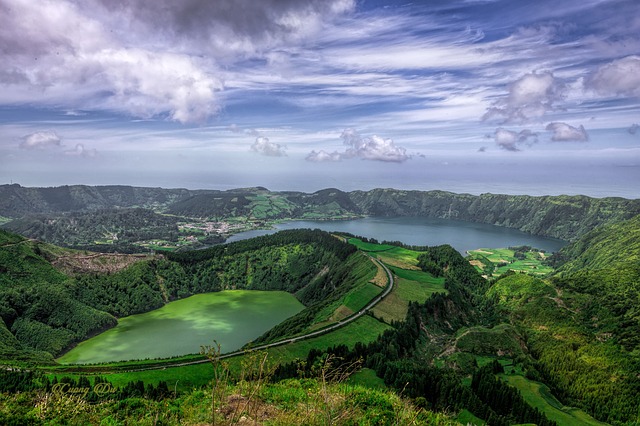
Rows of small volcanic cones and green undulating expanses that end abruptly on the blue sea: this is the type of view offered by most of the panoramic points (miradouros) of São Miguel, from which you can admire the islets along the coast, such as the magnificent one that rises to Vila Franca do Campo, or the Faraglione of Mosteiros, glorious at sunset, when seen from the distant Ponta do Escalvado.
In the Nordeste region, among the exuberant vegetation, the belvederi are gardens in which anyone can make use of the existing structures to prepare a barbecue while enjoying exceptional views. Equally beautiful is what is offered to those visiting the Lomba do Cavaleiro viewpoint: a wide view of the whole Povoação crater and its popular seven hills.
Natural hot water pools are one of the wonders of nature in São Miguel: spectacular, like that of Caldeira Velha, with its transparent stream of water that flows along the veins of a vivid ocher color encrusted in black rock; majestic, like that of ferrous yellowish water of the Terra Nostra Park, a botanical garden without equal; secret, such as the crystalline pools and the toning mud from Poça da Beija; quiet, like in the historic thermal building of Caldeiras of Ribeira Grande, dating back to 1811 and surrounded by trees and smoking fields; or even shocking, in the “hydropolis” of Furnas, where there are dozens of thermal springs, fumaroles and natural effervescent bicarbonate waters, which make this location a Mecca of world thermalism and a virtual bottling station.
COAST
High cliffs lined with green woods, black basalt cliffs that penetrate the sea, headlands and inlets, inviting plains and numerous gray volcanic sand beaches are the brushstrokes that make up the picture of Miguel’s coastline, which certainly deserves a careful look and a visit no hurry.
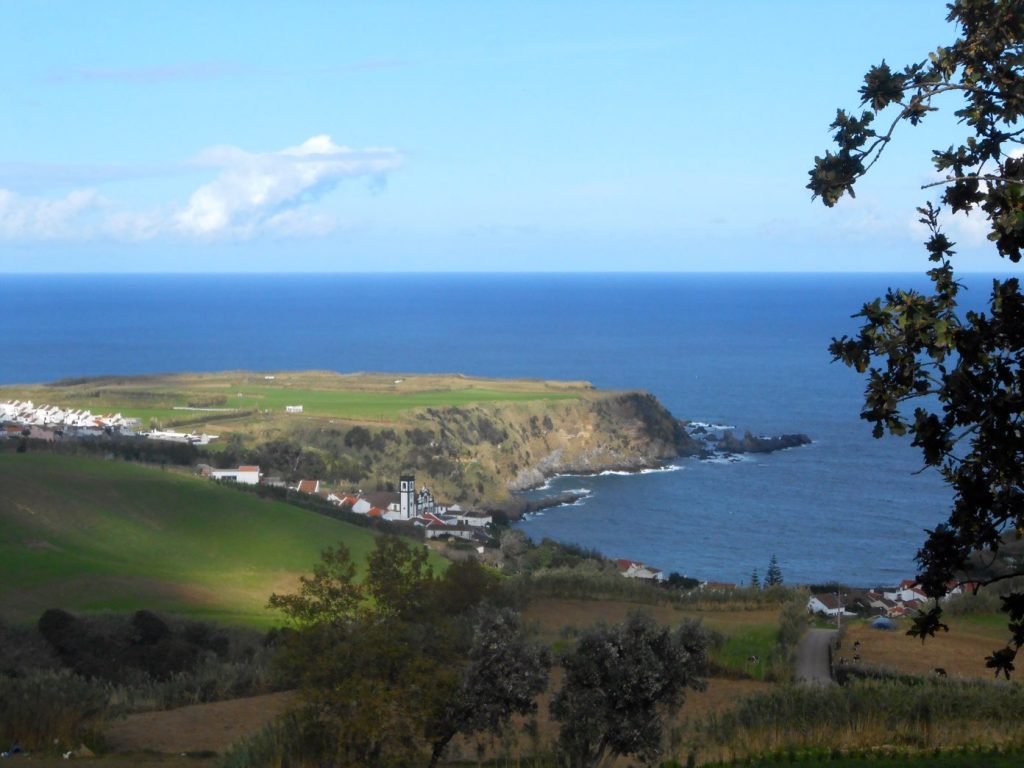
On the southern coast, beaches such as Pópulo, Vinha da Areia and Ribeira Quente are very popular, and invite you to take some nice baths. But for those who prefer greater intimacy in their contact with nature, the beaches of Amora, Viola, Lombo Gordo or Mosteiros, among many others, are the right choice. Excavated between the rocks and black rocks, equipped with solar and full of crystal clear water, there are maritime pools and natural pools in various points of the island: Capelas, Calhetas and Lagoa are some of these locations.
And (cherry on the cake!), In Ponta da Ferraria, nature takes care of heating the sea water with volcanic thermal waters that allow thalassotherapy in the middle of the Atlantic, in a splendid natural environment. Between Povoação and Furnas, in the areas of Nordeste and Água Retorta, and in all cases where the uneven relief resolves into imposing cliffs, it is always worthwhile to follow the paths that since ancient times connect the villages to the houses built Along the coast.
ATTRACTIONS
The size of the island and the abundance of infrastructures and services explain the large number of experiences that can be lived in São Miguel, a real gateway from which to explore the entire archipelago.
On the ground, unique landscapes open to those who walk along the numerous existing paths. Horse riding and cycling are other recommended ways to enjoy the beauty of the island. The two golf courses of São Miguel, in addition to sports, allow direct contact with intact nature. Those who prefer more ‘action’ tourism can explore the island by jeep or 4 × 4, quad or BTT.
A paragliding flight allows you to take singular photographs and to appreciate the magnificent lakes from a different perspective than usual. It is also possible to discover the underground reality of the island by visiting the Gruta do Carvão; and there are various sections of cliff where you can practice climbing.
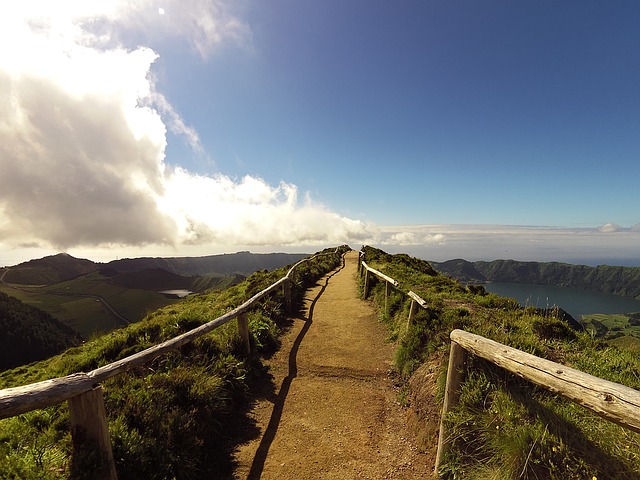
Inside the Green Island you can do rowing or engage in other water sports on the lakes that occupy the volcanic craters. In some lakes and streams it is possible to fish (by requesting the appropriate license), but it is certainly along the rocky shores of the sea that fishing lovers find their paradise. Diving, whale and other whale watching and deep sea fishing are activities in great development. Surfing and bodyboarding predominate on the north coast.
Volcanic sand beaches such as those of Pópulo, Água d’Alto and Ribeira Quente, natural pools spread all around the coast and the thermal bathing facilities of Ferraria and Furnas are ideal places to relax after so many emotions and recover energy before a new one. adventure.
HERITAGE AND TRADITIONS:
ARCHITECTURE
In the city of Ponta Delgada, nestled around a natural bay and made unmistakable by the three arches of the Portas da Cidade (‘city gates’), there are many historic civil buildings and many churches. Among them, the baroque Matriz (cathedral) de São Sebastião and the church of Todos os Santos are particularly interesting.
In Ribeira Grande, the chromatic game between the white walls and the carved stone is particularly striking, be it basalt or ignimbrite. This contrasting effect is visible not only in the churches (such as that of Nossa Senhora da Estrela, which also has a monumental staircase and a singular black bell tower), but also in the Oito Arcos bridge (eight arches) or in the elegant palaces with balconies wrought iron.
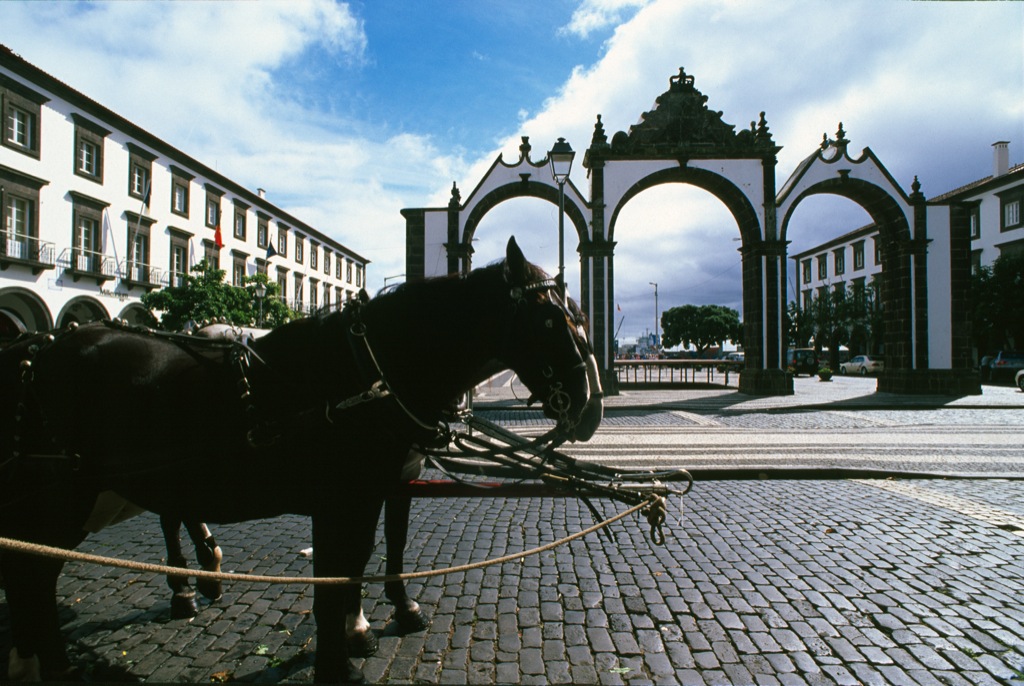
The water mills, testimony of a past time, can be seen in various places on the island. In Ribeira dos Caldeirões, in the municipality of Nordeste, there is an elegant restored specimen, which is the backdrop to the beauty of the waterfall that flows into the stream of the same name.
CULTURE
Figures of national importance were born in São Miguel such as the poet Antero de Quental (1842-1891) and the politician and essayist Teófilo Braga, who was elected President of Portugal in 1915. The poetess Natália Correia (1923-1993), personality of great cultural, civil and political importance, he wrote the text of the official anthem of the Azores, which reads: De um destino con brio alcançado / colheremos mais frutos e flores / porque è esse o sentido sagrado / das estrelas que coroam os Açores (‘ From a destiny conquered with pride / we will still reap fruits and flowers, / because this is the sacred meaning / of the stars that crown the Azores’, with evident reference to the flag of the Region).
In painting, the works of Domingos Rebelo (1891-1975), author of the famous painting entitled Os Emigrantes (‘The emigrants’), are worth mentioning. In the field of sculpture, those of Canto da Maya (1890-1981) are very important. The Carlos Machado Museum, installed in the Convento de Santo André, in Ponta Delgada, preserves extraordinary testimonies of the Azorean culture, with important collections of sacred and secular art, regional ethnography, toys and natural history.
CRAFTS
The ceramic and terracotta industries are truly traditional. In Vila Franca do Campo, clay is used to make rustic and daily use pottery. In Lagoa, ceramics acquire decorative characteristics thanks to motifs mainly painted in blue. In Ribeira Grande, hand-painted panels of artistic ceramic tiles (azulejos) are still hand-painted.
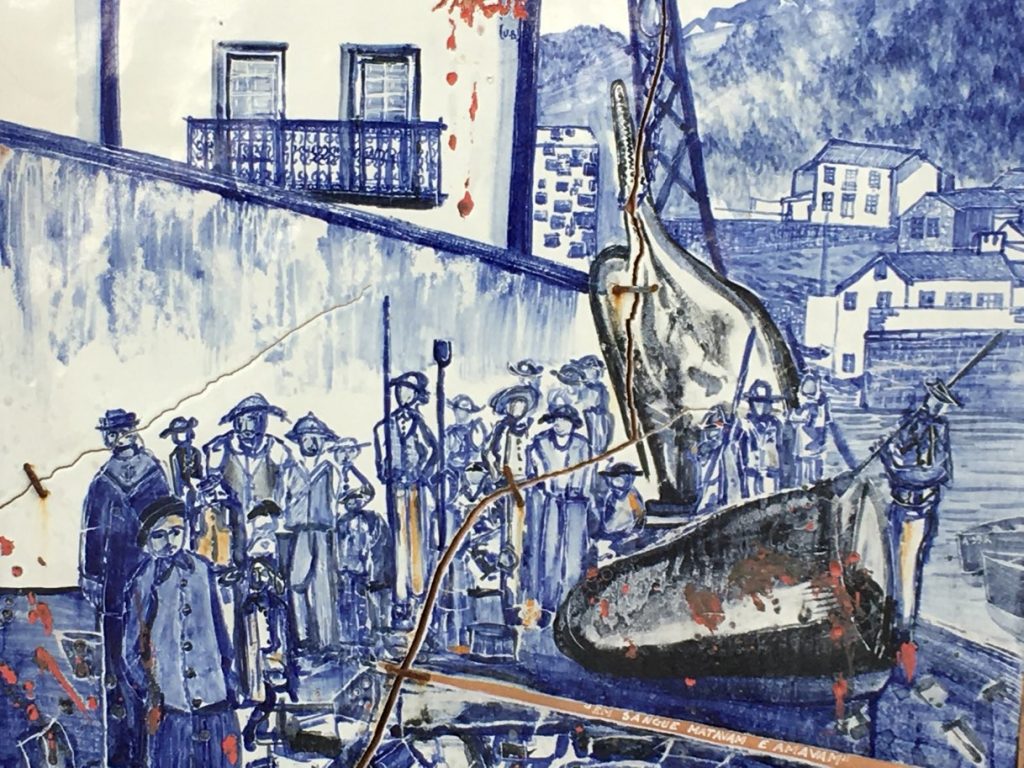
From the agricultural tradition, the characteristic corn leaf dolls were born, dressed in typical regional costumes, while from the world of fishing come the delicate flowers made of fish scales that form miniature bouquets.
FESTIVITIES
The Feasts of the Holy Spirit are a religious tradition present in all the islands from May to September: the nerve centers of these feasts are the so-called “impérios” (mobile or fixed altars).
Intrinsically linked to São Miguel is the centuries-old Feast of the ‘Senhor Santo Cristo dos Milagres’, which was born as a form of veneration of the wooden bust of Christ preserved in the Convent of Esperança, in Ponta Delgada. The festival lasts three days, but its climax is the fifth Sunday after Easter. The Romeiros (‘pilgrims’) of São Miguel give life to another typical tradition: they are groups of men who, during Lent, walk and pray throughout the island, touching all the churches and chapels in which it exists an image of the Madonna.
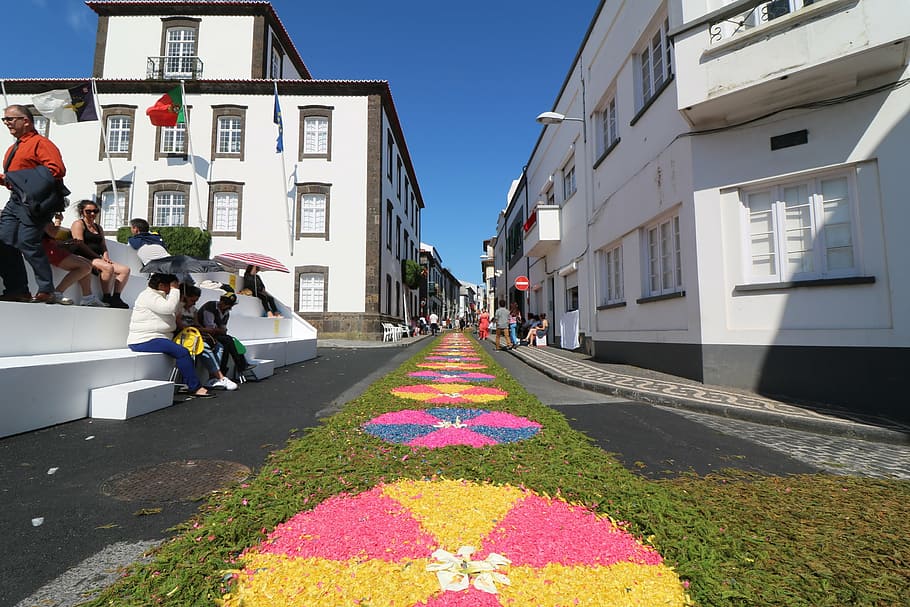
On June 29, the Cavalhadas de São Pedro (‘cavalcate di S. Pietro’) begin in Ribeira Seca, in the municipality of Ribeira Grande: it is a parade of knights dressed in a very peculiar and colorful way (they impersonate a king, gods knights, lancers, dispensers and cornet makers), while horses are equally adorned in a very particular way.
The Carnival is experienced with great intensity in Ponta Delgada: the Batalha das Limas (a battle fought with shots of paraffin balls full of water) is still a very lively tradition, involving groups that challenge each other on the streets trying to wet their opponents to the bones. But this festive period also includes the characteristic gala dances, whose participants are rigorously dressed, men in tuxedos and women in evening dress. The allegorical parades take place a little across the island, among the wings of enthusiastic spectators.
Popular dances and band concerts are frequent in various locations, especially on the occasion of celebrations in honor of their patrons. New Year’s Eve, in Ponta Delgada, has recently gained greater importance after the construction of the complex called Portas do Mar (‘Gates of the sea’), with the marina and the dock for cruise ships. This new city center has also become the usual stage for musical performances and other events. Home to various exhibitions, with its many bars and restaurants it contributes to the city’s vibrant nightlife.
GASTRONOMY
Among the various crops introduced to the Azores, tea has gained great importance. The plantations of the Gorreana factory and those of Porto Formoso, which stand out against the horizon like seas rippled by waves of green leaves, are unique in Europe.
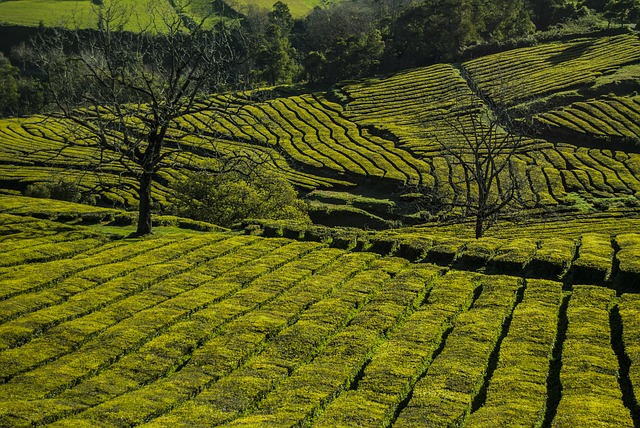
Visiting the museum factories you will learn the history of this cultivation and that of the evolution of the machines used, before the well-deserved cup that allows you to taste this exquisite Azorean product.
In Furnas, the pots filled with the various meats and many vegetables that make up the famous cozido (a peculiar mixed boiled meat) are closed in sacks and buried in the soil of some areas with high geothermal activity.
Cooking takes about five hours: but before tasting this appetizing dish packaged in the natural heat of the earth, it is worth going to see the extraction of the pots, hoisted by vigorous arms that lift the heavy pots attached to a rope.
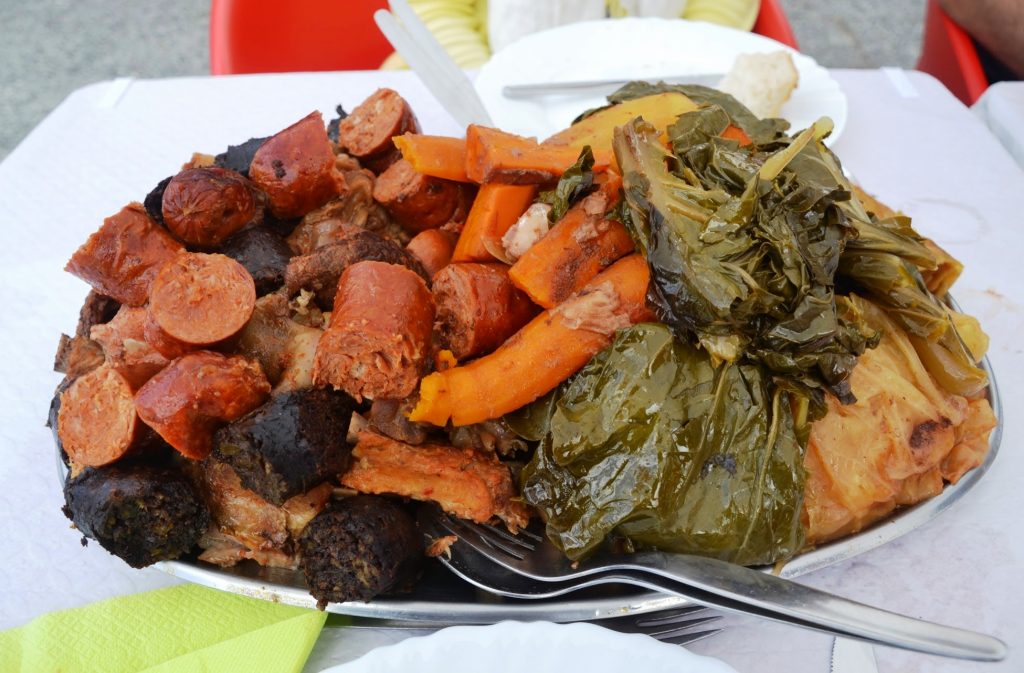
Another tradition of São Miguel is the cultivation of exotic fruits such as pineapple, anona, araçá and maracujá: all excellent fruits to be consumed fresh, but also used to pack liqueurs. Pineapple greenhouses, spread in the areas of Fajã de Baixo, Lagoa and Vila Franca do Campo, continue to apply ancient methods that can be discovered during a guided view.
In the local gastronomy there are many dishes based on various types of fish, but all share one characteristic: the absolute freshness of the product. There are also many seafood, and some of them are really a curiosity: think of the cracas (barnacles), crustaceans that must be cooked in the sea water. The meat from cattle raised in open air pastures is tender and tasty.
In the appetizer dish, the famous pimenta da terra (sweet red pepper paste) is usually combined with fresh white cheese, but it is also typical of many island recipes. Bolo lêvedo, a lightly sweet crushed bread, typical of Furnas, is widespread and can be presented at any meal.
Among the confectionery products, the queijadas of Vila Franca do Campo, milk-based pastes, deserved special fame. After a good meal, smokers can treat themselves to a cigar or cigarrilla made from the finest local tobacco.








